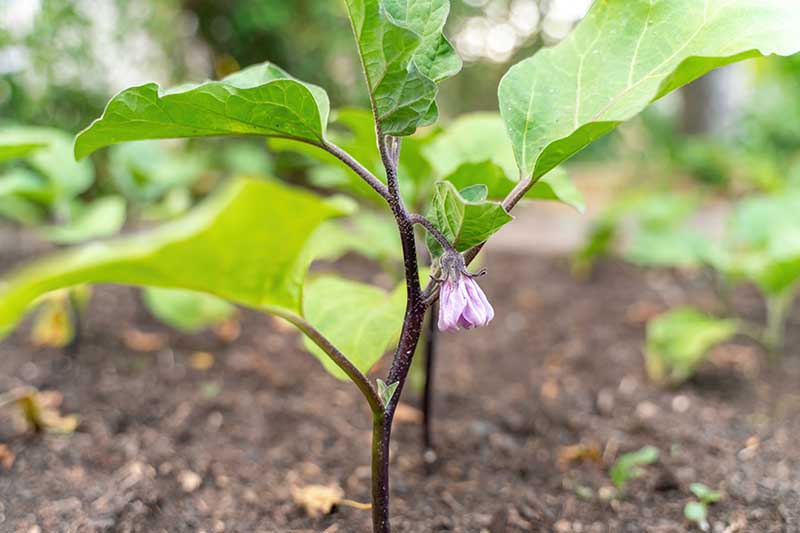Eggplant is native to India and requires a long, warm growing season for optimal yields. They also need proper eggplant spacing in the garden for maximum yield. So, how far is it to get maximum yield and healthy plants from eggplants? Eggplants will grow to 2 to 4 feet tall and stretch 2 to 4 feet. Eggplants are 18 to 24 inches apart on raised beds, and 30 to 36 inches apart in each row, according to Cornell University. The spacing of vegetables in growing beds is the same as in-ground gardens. Read on to learn more.
Table of Contents
Proper Eggplant Spacing
The growth habit of eggplants is similar to tomatoes; however, eggplants are planted more closely than tomatoes, and some varieties do not require stakes. There are also some smaller eggplant varieties and ornamentals that can be grown in containers. Either way, proper spacing between eggplants is critical to the amount of fruit they bear.
How Far Apart to Space Eggplant?

Whenever you plant a garden, there should be some consideration and planning when deciding where to place certain plants and how far apart they need to be drawn to get the most out of the plot. Plants that are too far apart waste much-needed space in the garden, while those that are too close together compete for light and air, effectively reducing potential crop yields. Plant your six- to eight-week-old eggplants outside after the danger of frost in your area has passed. Choose a location that gets at least six hours of sunlight a day—preferably a sunny spot. Eggplants in the garden should be 18-30 inches apart. While 2½ feet apart will prevent you from accidentally snapping branches when harvesting eggplant fruit, two feet apart is fine too. If you are growing a lot of eggplants, you will need to make rows, leaving 30-36 inches of the area between the rows. For dwarf varieties, space them 16-18 inches apart. For example, if you want to accompany plants in eggplants, say, with nitrogen-boosting beans, leave enough space for both plants—about 18-30 inches from each plant. For blooming annuals, plant 6-8 inches from the bottom of the eggplant. Once you’ve transplanted your baby eggplants, fertilize and use a nitrogen-rich side dressing around the eggplants, again when the eggplants are half-grown, and again after you’ve harvested the first fruit.
Planting and Growing Eggplant
Sow your eggplants indoors about eight weeks before you plan to transplant them. Cornell University recommends planting seeds 1/4-inch deep and keeping the soil warm at a temperature of at least 60 degrees Fahrenheit. The ideal temperature for germination is 80 to 90 degrees, and germination will take 7 to 10 days.
Transplant your eggplant into the garden where it will thrive. Eggplants need full sun and fertile, well-drained soil. To bear good fruit, the plants need at least two months of warm weather, with nighttime temperatures around 70 degrees. These plants do not grow well in cold soil, and frost will kill the eggplant.
Transplant eggplants into your garden a few weeks after the last frost. If you live in a cooler climate, consider planting raised beds or mulch to keep the soil warm. Eggplants also grow well in containers. For best results, rotate crops and plant eggplants in designated locations only once every three to four years.
Caring for Eggplant
Eggplant blooms in midsummer and late summer with glossy purple fruit. Fine Gardening recommends watering eggplants twice a week. Mature plants can be watered less, but don’t let the leaves wilt. Water deeply, but avoid standing water that can drown or damage the eggplants.
Eggplant bears heavy fruit and may thin the eggplant. Fine gardening advice, consider a tomato cage or a wire ring to help support the plants. The eggplant is to be harvested when it is shiny. You can also harvest the vegetables when they are smaller to avoid seeds. Eggplants typically set four to six fruits and can be harvested 55 to 85 days after transplanting, advises Washington State University Extension.
Near the end of the growing season, about two to four weeks before the first expected frost, cut back any remaining flowers to encourage fruit ripening and prevent plants from producing new fruit.
Conclusion
Eggplant also known as eggplant or Burlingame is a warm-weather vegetable harvested mid-summer to late summer. Eggplants are 18 to 24 inches apart on raised beds, and 30 to 36 inches apart in each row.

















